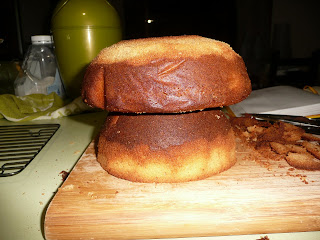When I can’t afford to get my roots dyed, I like to swap half the cost for a Magic Toadstool cake for my hairdresser’s daughter.
Ingredients:
2x340g packets buttercake mix
35cmx50 prepared board
1 ½ quantities butter cream (One quantity= beat 125 softened butter in a small bowl with electric mixer until it is as white as possible. Gradually beat in 1 ½ cups (240g) sifted icing sugar and 2 tbsp milk, in 2 batches. Flavour and colour as required.
Yellow and pink food colouring
15cm round cardboard
Decorarions:
4 pink fruit sticks
2 spearmint leaves
8 mini heart lollies
1 yellow fruit stick
25 large heart lollies
24 silver cachous
3 large white marshmallows
3 white marshmallows
1 tsp cocoa powder
Assorted mini fairy statues
Method:
1. Preheat oven to 180C. Grease 1.25L (5 cup) and 2.25L (9 cup) pudding steamers.
2. Make cakes according to directions. Pour mixture into steamers until three-quarters full. Bake smaller pudding about 35 mins and larger pudding about 55 mins. Stand cakes in steamers 5 mins; turn onto wire rack to cool. Using serrated knife, level cake tops.
And here is where I ran into problem number one. After turning my nose up at the suggestion that I use packet cake mix, I decided to find a cake recipe that would suit the pudding steamers—simple, but not a cake that would rise too much because of the risk it would collapse in such a narrow space. I decided on AWW’s golden syrup coconut cake.
So far, so good.
After the recommended cooking time of 40 mins, the cake was nowhere near cooked in the centre. I foiled it and waited. More than an hour passed before it was done.
A bit brown on the outside, but as good as can be expected. Now to ease him out of his pudding steamer.
 |
| Oh. |
No time for nonsense any more. I went for AWW’s basic butter cake and hoped it wouldn’t collapse. I also lined the absolute crap out of the large pudding steamer.
They took a little longer than described in the recipe which resulted in them browning a bit too much on the outside. No biggie, I need to trim them to make the perfect shape anyway.
Now for the fun part!
3. Place small cake on board. Tint half of the butter cream with yellow colouring; spread all over cake for toadstool stem.
Firstly, can anyone tell me how those AWW ladies get their icing so smooth? We tried all sorts of utensils but it still looked a little on the ‘rustic’ side.
4. Position large cake on cardboard round, cut-side down. Position large cake on toadstool stem for toadstool cap. Tint remaining buttercream with pink colouring (we used purple), spread all over cap.
5. Place pink fruit sticks, side by side. On flat surface; trim tops of sticks to make rounded door. Position on toadstool stem for door.
Musk sticks can be placed in the microwave for easy shaping. They can also be placed in the microwave for a couple of seconds too long and turn into a lumpy, exploding pink pile.
6. Split spearmint leaves in half centre; slice halves into three pieces. Use centre pieces for stems and side pieces as leaves; position around toadstool stem. Position two mini heart lollies at top of each spearmint stem for flowers (I couldn’t find mini hearts so Chon had the ingenious idea of using tiny slices of musk stick).
7. Cut yellow fruit stick into thin strips; using a little water, position on two large heart lollies; position on toadstool stem for windows (instead of this, I drew the windows with awesome edible glitter pens that I got from Coles. I also went a little crazy on the marshmallow toadstools).
8. Position 6 large heart lollies on board at front of toadstool for path. Decorate toadstool cap with cachous and remaining large heart lollies.
9. Using a little butter cream, attach large marshmallows on top of smaller marshmallows, sprinkle with sifted cocoa powder; position around toadstool. Decorate toadstool with fairy statues (this happened later).
Phew! After a day of angsting, we managed to pull off a fairly decent looking fairyland wonder Birthday surprise. I didn’t get to eat the magical cake myself but I hear it went down pretty well.
























